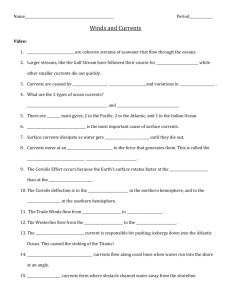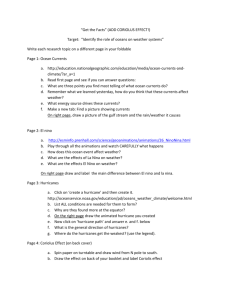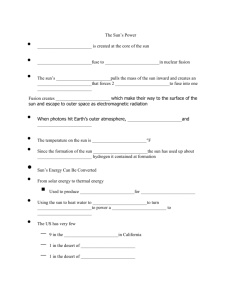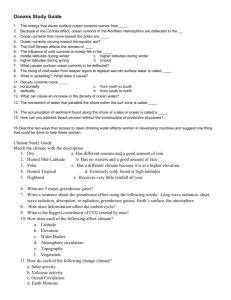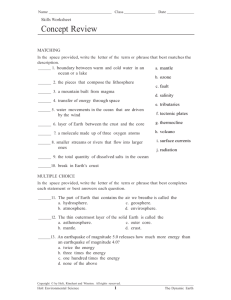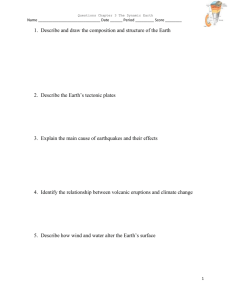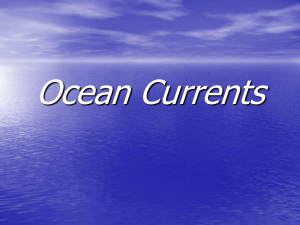EXPLORING CURRENTS
advertisement
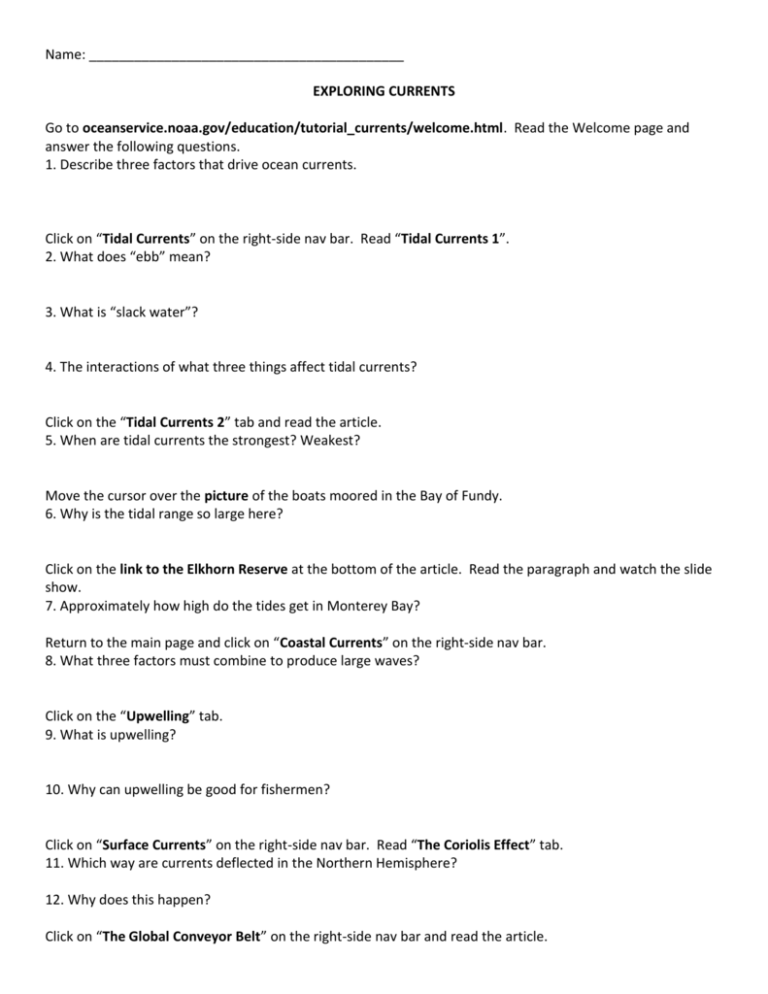
Name: __________________________________________ EXPLORING CURRENTS Go to oceanservice.noaa.gov/education/tutorial_currents/welcome.html. Read the Welcome page and answer the following questions. 1. Describe three factors that drive ocean currents. Click on “Tidal Currents” on the right-side nav bar. Read “Tidal Currents 1”. 2. What does “ebb” mean? 3. What is “slack water”? 4. The interactions of what three things affect tidal currents? Click on the “Tidal Currents 2” tab and read the article. 5. When are tidal currents the strongest? Weakest? Move the cursor over the picture of the boats moored in the Bay of Fundy. 6. Why is the tidal range so large here? Click on the link to the Elkhorn Reserve at the bottom of the article. Read the paragraph and watch the slide show. 7. Approximately how high do the tides get in Monterey Bay? Return to the main page and click on “Coastal Currents” on the right-side nav bar. 8. What three factors must combine to produce large waves? Click on the “Upwelling” tab. 9. What is upwelling? 10. Why can upwelling be good for fishermen? Click on “Surface Currents” on the right-side nav bar. Read “The Coriolis Effect” tab. 11. Which way are currents deflected in the Northern Hemisphere? 12. Why does this happen? Click on “The Global Conveyor Belt” on the right-side nav bar and read the article. 13. How deep can winds affect ocean currents? 14. What drives deep ocean currents? 15. What controls water density? 16. What role does sea ice play in deep ocean currents? Click on the “Global Conveyor Belt” tab and read the article. 17. Where does the Global Conveyor Belt (GCB) start? 18. How long would it take a drop of water to make one complete circuit around the GCB? 19. In which direction does the cold water travel? 20. In which direction does the warm water travel? 21. What role does the GCB play on the world’s food chain? Click on the “Effects of Climate Change” tab and read the article. 22. How could increased rainfall affect the temperature in Europe? 23. Describe how 3 different groups of people are impacted by ocean currents and/or ocean current data. Name: _______________________________________ EXPLORING CURRENTS REVIEW You may use your notes and the website to fill in the following statements. 1. The _________________________ of currents includes speed and direction components. 2. Three factors that drive ocean currents are: _________________________________, ____________________________________, and ____________________________________. 3. When a coastal tidal current ________________, it moves toward the land and away from the sea. When a coastal tidal current ______________, it moves toward the sea away from the land. 4. As a coastal tidal current moves from ebbing to flooding (and vice versa), there is a period during which there is no current velocity. This period is called ___________________________. 5. Tidal currents are most strongly influenced by motions of the _____________________________________. 6. When the moon is at full or new phases, the tidal current velocities are __________________ and are called _______________________________ When the moon is at first or third quarter phases, tidal current velocities are ___________________ and are called __________________. 7. “____________________ currents” occur when the moon and Earth are closest to each other. “_______________________ currents occur when the moon and Earth are farthest from each other. 8. Wave height is affected by wind ____________, wind _________________, and _____________________. 9. Breaking waves are caused by ____________________________________________________________. 10. _________________________ occurs when winds blowing across the ocean’s surface push water away from an area, causing subsurface water to come up from beneath the surface to replace the diverging surface water. Areas where this occurs are often good for ____________________, because ___________________ ________________________________________________________________________________________. 11. Earth’s rotation causes air circulating in the atmosphere to deflect toward the right in the Northern Hemisphere and toward the left in the Southern Hemisphere. This deflection is called ___________________. 12. Deep-ocean currents below 100 meters are driven by ___________________, in a process known as ________________________________________. 13. The global-scale system of deep-ocean currents is sometimes called the _________________________ _______________________________________________________________________________________. 14. Global ocean circulation resulting from deep-ocean currents is vital to the world’s food chain because _______________________________________________________________________________________. 15. Global ocean circulation resulting from deep-ocean currents could be disrupted by global warming if ________________________________________________________________________________________.


